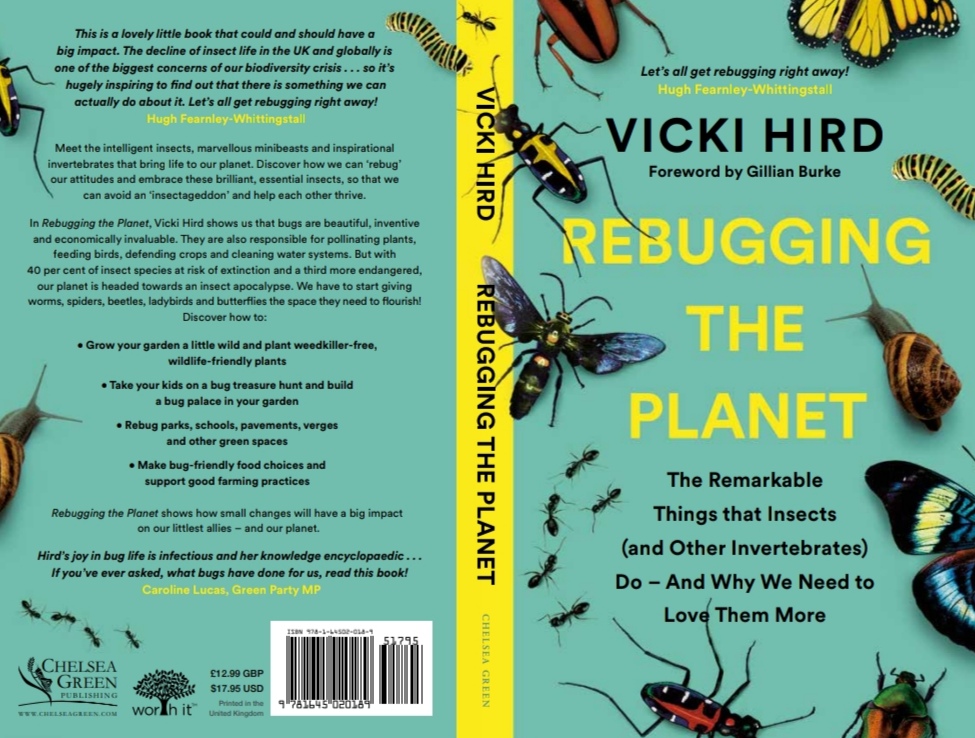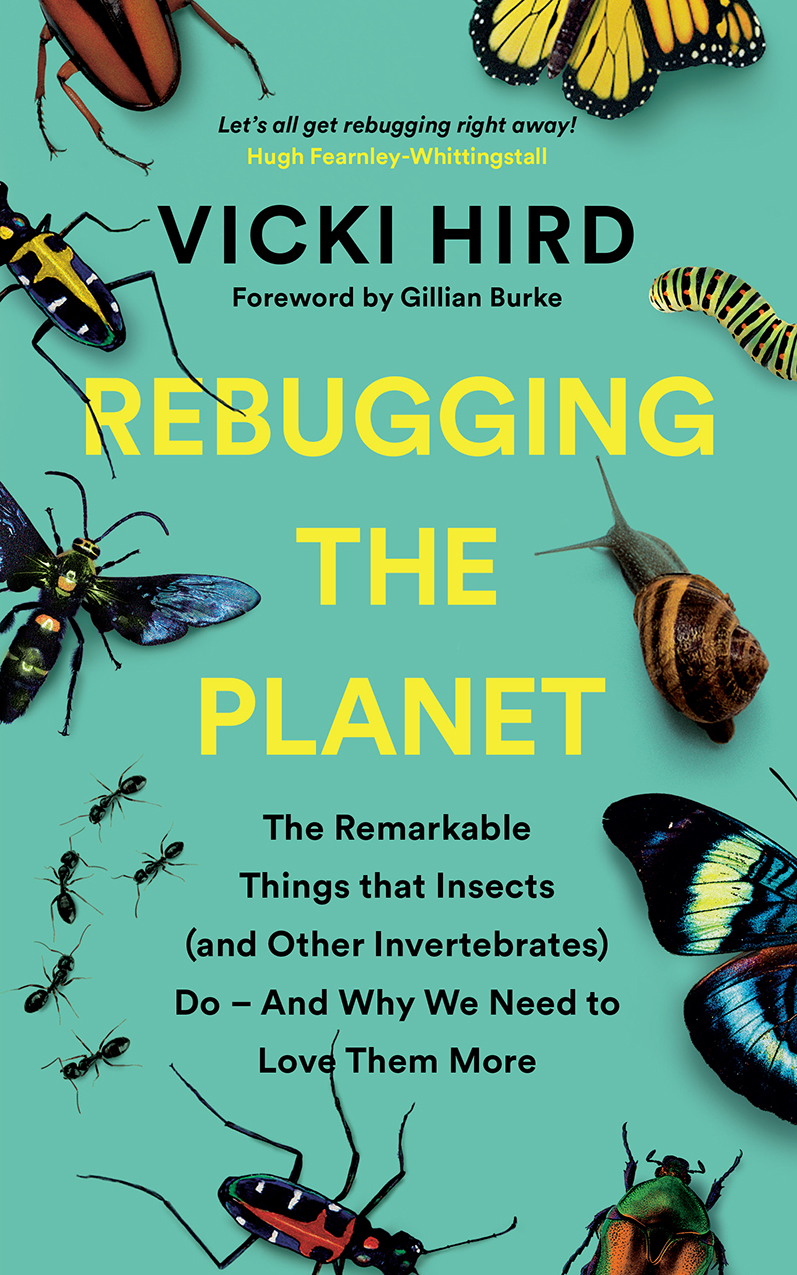Vicki Hird has a passion for insects, and this book brings home to us how much depends on the well-being of invertebrates in the world. Insects are a cornerstone in our ecosystem, and we must reverse the current dangerous decline in bug populations (40% of insect species are at risk of extinction and 33% more are endangered). We are heading towards “Insectageddon.†After reading this book, I found myself being much more careful about gathering up insects inside the house and taking them outside, where I imagine they will thrive better. Did you know that spiders rest calmly in your gently closed hand? They do not wriggle and tickle!
We need to overcome any aversion or indifference to creepy-crawlies, and change our attitudes to respect, appreciation, and some humility if possible. Insects pollinate plants, recycle waste into nutrients, control pest species, add air channels in the soil, and ultimately return themselves to the soil food web.
 Vicki explains how to rebug our city green spaces, grow gardens without pesticides and weedkiller, teach children to appreciate small creatures, make choices that support insect-friendly (planet-friendly) production of food and fiber, and make wider choices that affirm human dignity and equal rights.
Vicki explains how to rebug our city green spaces, grow gardens without pesticides and weedkiller, teach children to appreciate small creatures, make choices that support insect-friendly (planet-friendly) production of food and fiber, and make wider choices that affirm human dignity and equal rights.
This book has charming insect drawings, and delightful anecdotes: “I was never going to get the pony I wanted, so I settled for an ant farm at an early age.†Studying biology at school led Vicki to a summer job observing bees at a research station. A later job investigating cockroaches led her to respect them and realize that it is humans that need better control, more than roaches do.
Vicki has been an environmental campaigner, lobbyist and researcher for about 30 years, and is the mother of two children. Vicki is also head of the Sustainable Farming Campaign for Sustain: The Alliance for Better Food and Farming, a UK alliance of organizations and communities advocating for healthy food, people and environment, and equity in society. She has a website for Rebugging.
Those over 50 (and maybe 40) will have noticed that long car drives no longer lead to cars covered in smashed bugs. There are fewer butterflies. More than twice as many insect species as vertebrate species are at risk of extinction. I noticed on a trip to England after an absence of a couple of years, that the number of sparrows has plummeted. We are more likely to get distressed about the charismatic mega-fauna, but less so about formerly ubiquitous sparrows, and even less about insects. There may be 4 million unidentified species of insects (as well as the million we know). In the UK 23 bee and wasp species have become extinct since 1850.
So, what is ‘rebugging’? It is a form of rewilding (the introduction of similar-to-natural ecosystems and missing species into an area and then waiting to see if the species can settle in). It is somewhat controversial, and alone is insufficient to cause all the changes we seek. We also need changes in policy, lifestyle, and civic involvement. This book provides information, encouragement and tools to act.
What would the world be like without bugs? “A great image that has been doing the rounds is a picture of a bee saying, “If we die, we’re taking you with us.†It’s not an empty threat, but a fact – we would not last long without insects. Our flowering plants would die off; all the species that dine on insects would be lost, followed by the next ones up the chain; dead animals would pile up undigested; trees would cease growing in the compacted airless soil.
But this is not our inevitable future. We can step back, as we have done when the dangers of DDT, CFCs, and nuclear weapons became blindingly clear. We can work to restore habitat, reduce damage and make political and economic structural changes at all levels in society. We can start by “rebugging our attitudes.â€
How can we protect and nurture invertebrates? We can help research what’s out there. We can encourage others to be concerned and take action to protect invertebrates. We can teach others about the value of insects for human well-being. We can make havens for wildlife, convert every city street into a biocorridor, share designs for pollinator-friendly gardens, encourage conservation of water and other natural resources, make urban farms and community gardens.
The book is studded with sidebars on aspects of the value of insects, such as “How much is a bee worth?†(The answer is over $3,000 per hectare in pollination services, for wild bees) That’s more than 651 million GBP to the British economy.
Insects are food for many animals such as poultry, fish and pigs. And some insects could be food for humans. I ate a 17-year cicada last time they were in our area (2013). I was partly inspired by Jackson Landers’ book Eating Aliens. And really, if you can eat shrimp, you can eat meaty insects. But Rebugging isn’t mostly about eating insects, but rather preserving their lives, and benefiting from their contributions.
If you are still unsure what bugs do for us, the second chapter spells it out. We would be knee-deep in manure, leaf litter and dead animals within weeks, if there were no bugs eating it all, and enriching the soil. Tardigrades (water bears or moss piglets) are the most resilient animals known, able to survive extreme temperatures, pressures, dehydration, oxygen deprivation, starvation and radiation. They can remain in suspended animation for years until conditions improve. They have already survived all five mass extinction events, and some have been revived from a hundred-year-old sample of moss in a museum. Respect, please!
Avoid spraying wasps with pesticides-in-a-spray-can. They are as useful as bees and ladybugs, and are the best pest control we have for hauling away cabbage caterpillars. If you are more motivated to provide accommodation for ladybugs than wasps, keep moist dark places like old hollow stems, bark pieces and logs where the adults can overwinter. I could really use some early-spring-wakening ladybugs in our hoophouse to tackle the aphids!
Carefully introduced biological bug control can reduce the amount of pesticides used. A scientific risk assessment is an important first step, though. The 1930’s introduction of cane toads in Australia for pest control was a terrible mistake. The toad was a worse pest than the bugs had been. There are many more success stories than disasters!
Rewilding can be complicated – looking at a huge overgrowth of creeping thistle is alarming. Happily, the biggest migration of painted lady butterflies came over and laid eggs on the thistles. The resulting spiny black caterpillars ate the thistles down to the ground. UK organizations have been creating maps of “insect superhighways†they are calling B-Lines, that will be filled with wildflowers so that insects and other wildlife have continuous corridors to travel from one area to another. There’s a two-page spread of possible actions to help the rebugging process, starting with publicity and education, and moving onto helping build bug-friendly habitat in public places and workplaces and private gardens.
Green public spaces can include a wide variety of invertebrate species. Look on derelict land, in cemeteries, along grass verges, and even on golf courses. Many companies and local authorities are now wanting to manage their land in ways that support more wildlife, and with encouragement might move another step in that direction. Tiny public orchards and forests are being planted in some places. There is a sidebar of actions to reduce deliberate, accidental, and thoughtless damage to insects.
After starting small and local, you might be ready to expand your ambitions and commitment. The overall total mass of insects is estimated to be falling by 2.5% every year. One big factor pushing species towards disaster is climate change. This is a big one to tackle, and yet we must. Overwintering numbers of monarch butterflies (the celebrities of the insect world) have dropped to less than 1% of their 1980’s population. Yes, compared with 40 years ago, the population is now just 1/100 of what it was. When food species arrive, peak, or leave earlier in the year due to changed temperatures, the predator species goes undernourished. Pesticide contamination gets a lot of blame too.
Water pollution also harms diversity. Leached fertilizers in estuaries have created ocean dead zones. Combating climate change might not be what you expected to read about when picking up a book on rebugging the planet, but it is vitally connected. We can learn from bugs about climate management. Honeybees have learned how to mob an invading Asian giant hornet and cook it to death. In Brazil, scientists discovered an area of 200 million termite mounds each spaced 60 feet from its neighbors. This is all one colony, connected underground. Some of the mounds are over 4,000 years old. They have created a stable environment for millennia. The methods of ventilation and gas exchange could be copied for human habitation.
Are 5G phones heating insects 370% above normal levels and cooking them in the electromagnetic fields they generate? It could be true, based on research on models. The action list at the end of this chapter urges us to avoid 5G phones if we can, and not to use them outdoors if we must have one.
The chapter on why our farming, food and shopping all need bugs opens with a discussion on almond milk. The “dark reality†is that huge almond plantations need millions of bees brought in every year for pollination. Thousands of colonies are moved in to California’s Central Valley, for example. 30% of these bees die, because the environment is hostile, devoid of crops other than almond trees. Local wildlife cannot survive either.
It is a mistake to think that all vegan milk-substitutes are environmentally better than all dairy milk. It takes roughly 4 gallons of water for every gallon of milk a cow produces. Almond milk is much more intensive on water use: it can take up to 101 gallons of water to grow 1 cup of almonds, plus another 3 or 4 cups of water to manufacture almond milk. In fact, many commercial almond milks only have about 2% of almonds in them – the rest is water!
Bugs and other small animals can thrive in pastures if the livestock management is done well. The stock numbers and types are important.
Did you know that more than 70% of the world’s fish stocks are over-fished, depleted or collapsed?
We could also consider the impact of our decisions about textiles, timber and metals, on wildlife and ecology. The average person in the UK now buys over four clothing items a month! Less than 1% of clothing textiles is recycled. The waste mounts up. Forests are destroyed to make way for cotton plantations. Even if organically grown, cotton monocultures destroy habitat of thousands of species of butterflies, moths, termites, wasps, bees, and other bugs. Ironically, the cotton crop is then a sitting target for the bollworm moth. Genetically modified cotton was developed to overcome bollworm problems. A few countries resisted the siren call of GM cotton, and use integrated pest management (IPM) instead. They have lowered costs and increased yields.
While worrying about cotton, let us not forget synthetics and the huge problem of microplastics. In 2016, for example, 65 million tons of plastic textile fibers were produced. They do not decay. They are found everywhere on the planet, from the Arctic to the ocean depths. Ingestion of microplastics causes problems for marine life. The dyes cause disease, and can kill corals.
The action list for this chapter focuses on reducing waste. Think before you buy, think before you throw away. If you can, switch to consumption of locally sustainably produced goods.
The action lists that close each chapter get longer, the connections get wider. Politics and the economy might not be the direction you expected from this book, but these topics are all part of the connected system, and all need consideration and action. Termites and corals co-operate within their colonies to create and maintain large healthy populations: we can do it too. (Corals are symbiotic associations of bugs (coral polyps, which form the exoskeleton) with several thousand species of animals and plants living within. Algae provide oxygen and carbohydrates.)
Big investors own shares in seed companies, just to make money. They have no interest or incentive to protect bugs or any aspect of the ecology. “It’s as if some beetles decided to take all the ants’ food supplies even though they cannot eat or use them. Money accumulation is hard to eat.â€
Frustratingly, vested interests have too much power in decisions that affect large groups of people. We tend to avoid tackling entrenched societal problems. Vicki suggests three big areas to understand and deal with: poor governance and politics; inequality and poverty; runaway consumerism and waste. If you only wanted to read about saving beetles, you might be tempted to put the book down at this point. However, in order to save beetles, we need to look at the underlying causes of beetle die-offs.
Decisions on land use are often made by corporations and investors less focused on protecting biodiversity, and more on profits. We need to show them that enlightened self-interest can protect their financial success for the long haul. Some corporations are seeing this now that climate chaos is biting hard. Pushing humans to get three-quarters of their calories from just four crops (soy, wheat, rice and maize) may bring in fast bucks, but gives little resilience against climate change and extreme weather conditions, and is bad news for biodiversity.
Research has shown that as social inequality grows, so does harm to biodiversity, which leads to more inequality. Financial pressure from profit-seekers drives down wages, leading to a demand for ever cheaper food, spiraling to lower costs of production. They wring out higher short-term yields. Sustainability of food production goes to the wall. Desperate people take desperate measures to cover their basic survival needs. In 2020, the UN announced: “to bend the curve of biodiversity loss, we need to bend the curve of inequality.â€
The action list for this chapter is over 5 pages, demonstrating the broadening of the goals. Campaigning, lobbying and voting; pushing governments and economists to balance social and environmental concerns and work for sustainable outcomes; requiring corporations to show much stronger accountability for all the results of their activity; supporting companies that are taking steps to lower their environmental damage and increase co-operation with others, strengthen international treaties and hold nations to their commitments on biodiversity and limiting climate change.
This probably sounds overwhelming, but “You don’t have to rebug aloneâ€! You can join (or start) local organizations working on an issue you feel strongly about. The book contains a directory of some organizations (mostly in the UK). There is some help on starting lobbying, which most of us have not done before. The resources include guides on campaigning and influencing people. You can reduce your own carbon footprint and encourage others to do so. Big change is needed, but some days it’s restorative to “clean our own house†rather than go out lobbying.
Book Review: Vicki Hird, Rebugging the Planet: The Remarkable Things that Insects (and Other Invertebrates) Do – And Why We Need to Love Them More
Chelsea Green Publishing, September 2021, 224 pages, $17.95
Book Review by Pam Dawling
Purchase Rebugging the Planet: The Remarkable Things that Insects (and Other Invertebrates) Do – And Why We Need to Love Them More HERE!
VABF has partnered with independent bookseller, Stone Soup Books, in Waynesboro, Va. Buy this book, and ANY of the farming books found on their website here, and 1/2 of the net proceeds from your purchase will come back to support VABF! Thanks for your support!








